ADSA-ES SuperSpeed USB - eSATA adapter
USB 3.2 Gen 1-eSATA 6G adapter to connect all SATA disks and drives.
| Input | USB 3.2 Gen 1 |
| Output | eSATA 6G |
| PC connection | USB type A-M, integrated connector |
| Device support | 2.5" HDD / SSD, 3.5" HDD, 5.25" ODD |
Where to buy
USB 3.0 adapter ADSA-ES allows you to quickly and easily connect any eSATA drive or SATA drive via a eSATA-SATA cable.
A smart helper for easily and quickly connecting external drives, NAS drives and optical drives to a computer – just plug it into the USB port of a computer and an automatic installation of drivers contained within the OS will take place. Thanks to being supported by the Plug and Play and Hot plug technologies, the drive is instantly ready for use.
The reading of S.M.A.R.T. information which monitors drive status and the support for putting the attached drive into a sleep mode enable easy drive status monitoring and help save energy as well as extend the life of the drive.
Thanks to the SATA III 6G and USB 3.0 interface, reading or writing speeds won’t be limited in any way.
Two LEDs indicate the connection to the USB 3.0 port as well as connection to PC and data transfer.
Input:
• USB 3.2 Gen 1 (USB 3.1 Gen 1 / USB 3.0) SuperSpeed USB rate of up to 5 Gbit/s.
• Connection vias built-in direct USB type A male connector.
Output:
• Standard eSATA conector with SATA 6G support.
• Supports 2.5" and 3.5" SATA III/II/I drives of all capacities, supports optical SATA drives.
Other features:
• Compatible with USB 3.2 Gen 1 / USB 3.1. Gen 1/ USB 3.0 and backward compatible with USB 2.0.
• Supports transmission rates 5000/ 480 /12 Mb/s (Super / High / Full Speed).
• Compliant with Serial ATA 3.1 specification (SATA/600), transmission rates of up to 6 Gb/s (600 MB/s).
• Compliant with Serial ATA 2.0 specification (SATA/300), transmission rates of up to 3 Gb/s (300 MB/s).
• Compliant with Serial ATA 1.0 specification (SATA/150), transmission rates of up to 1.5 Gb/s (150 MB/s).
• The total bandwidth / transmission rate of the adapter is determined by the USB 3.0 interface used (theor. 5 Gbit/s).
• Supports booting from SSD / HDD / ODD.
• HDD Auto Spindown - automatic spindown when inactiv.
• HDD Turn Off - turns off the disk after removing the device or spinning down the PC.
• Possibility to connect your device while running thanks to the Hot Plug support.
• Full Plug and Play support.
• Supports reading of S.M.A.R.T. information.
• Supports USB Mass Storage Class.
• Supports Bulk-Only Transport Specification Revision 1.3 (BOT).
• Supports USB Vendor Command (Control Endpoint) and SCSI Vendor Command.
• Supports USB Host Controller for UHCI, OHCI, EHCI.
• Supports ATA/ATAPI Packet Command Set a ATA/ATAPI LBA48 addressing mode.
• Supports PIO, MDMA and UDMA data transfer mode.
• Red LED indicating the connection to USB charging (permanent light) and data transmission (blinking).
• Green LED indicating the connection to the USB 3.0 port.
• Supplying the adapter via USB bus, external power supply of connected SSD / HDD / ODD.
• Adapter dimension 50 x 52 x 13 mm.
• Weight 12 g.
Supported OSs:
• MS Windows XP / Vista / 7 / 8 / 10 and later, Windows Server 2003 / 2008 / 2012 / 2016 and later (supported are all 32- and 64-bit Windows OS versions), Mac OS X 10.x and higher, Linux with kernel 2.6.x and above.
• Note: Drivers are included with supported operating systems and are installed completely automatically. No other drivers need to be installed and are not even available.
Package contains:
• USB – eSATA adapter,
• packed in a cardboard box with the installation procedure included.
| Input | |
| interface | USB 3.2 Gen 1 / USB 3.1 Gen 1 / USB 3.0 / USB 2.0 |
| rate | 5000 / 480 / 12 Mbit/s (super / high / full speed) |
| connector | USB Type A male in-built |
| cable | no |
| Output | |
| interface | Serial ATA 3.1 |
| rate | 6 / 3 / 1.5 Gbit/s (SATA III / SATA II / SATA I) |
| connector | eSATA male |
| compatibility | all SATA I / SATA II / SATA III disks and drives |
| total permeability | 5 Gbit/s theoretically (given by USB 3.0 input) |
| Supported device | |
| 2.5" | yes (SATA HDD/SSD) |
| 3.5" | yes (SATA HDD) |
| 5.25" | yes (SATA DVD/DVD-RW/Blu-ray) |
| max. disk capacity | all, without limitations |
| max. height of 2.5" disk | all, without limitations |
| Supported features | |
| UASP | no |
| TRIM | no |
| S.M.A.R.T. | yes |
| boot from connected disk | yes |
| putting disk to sleep | yes (HDD Auto Spindown) |
| disk turning off | yes (HDD Turn Off) |
| automatic installation | yes |
| Plug and Play | yes |
| Hot Plug | yes |
| Other features | |
| design | plastic |
| indication | red LED indicating - connection to the computer's USB port (permanent light), data transmission (flashes) |
| indication | green LED - connection to the USB 3.0 port |
| dimensions | 50 x 52 x 13 mm |
| weight | 12 g |
| Power supply | |
| on the bus | for USB converter (USB bus power) |
| external power supply | for connected device |
| OS support | |
| MS Windows | 10 / 8.1 / 8 / 7 / Vista / XP (all 32- and 64-bit versions) |
| MS Windows Server | 2016 / 2012 / 2008 / 2003 (all 32- and 64-bit versions) |
| Mac OS | X 10.x and higher |
| Linux | kernel 2.6.x and higher |
Product package
- a cardboard box with an option to be hanged on the retail display stands
- package dimensions 14 x 8.8 x 3.6 cm
- weight of 1 pc package 51 g
- EAN 8595247902573
Export package
- number of pieces in the box: 100
- total weight of the box: 5.8 kg G.W.
- box dimensions: 45 x 35 x 38 cm
FAQ
A): Drivers are included with operating systems and are installed completely automatically. The external box (adapter / docking station) is detected as a standard storage device, such as a USB flash disk, no additional drivers are needed.
B): No other drivers need to be installed and are not even available. If you continue to have problems with your external box (adapter / docking station), check out more tips that can help you troubleshoot problems.
A): If the external box (adapter / docking station) is not displayed in "Device Manager", there may be a USB port malfunction. It is also possible that your computer has a poor power supply to USB ports and the power is not sufficient to operate an external box (you can detect by listening that HDD is not spinning). This is a problem especially for older computers, where the source part already works at the limit of its parameters. In this case, it would help to use a USB hub, with an auxiliary power supply, by which the external box (adapter / docking station) would be connected to the computer.
B): Try plugging the external box (adapter / docking station) into another USB port, preferably on the back of your PC. The external box (adapter / docking station) should be detected and the drivers loaded automatically. If the problem persists, plug the external box (adapter / docking station) into the USB port of another computer to verify its functionality.
A): If this happens, it means that the operating system failed to get the necessary information to install the drivers.
B): The cause may be a defective USB cable or damaged device. If the problem persists, plug the external box (adapter / docking station) into the USB port of another computer to verify its functionality.
A): If this happens, it means that the Windows operating system did not assign a drive letter to the new storage device.
B): If the drive letter is not assigned, open "Disk Management", right-click on the desired drive and manually assign the drive letter. If the drive letter can not be assigned to the disk, it is possible that the disk is formatted as "dynamic". If you want to keep disk data, connect it to the original device and make a backup of the disk. Then convert it to a normal disk, initialize it to MBR (or GPT, see other points), and then perform Low Level Format (e.g. using the Low Level Format Tool)
A): The newly purchased disk must be initialized before first use.
B): If the new disk is not initialized automatically, open "Disk Management", right-click on the desired disk and initialize it.
A): By initializing the disk, you can set the mode in which the hard disk will work.
B): You can use the partition with the master boot record (MBR) or the GUID partition table (GPT). For disk up to 2TB, use the MBR option, we recommend selecting GPT on a larger disk than 2TB. Subsequently, the initialized disk should be formatted.
A): If the external box (adapter / docking station) with a 3.5“ HDD is not displayed in "Device Manager ", the inserted disk may not be powered.
B): Make sure you have the power supply plugged in and the external box (adapter / docking station) turned on with the power switch. If the disk is properly powered, it should spin (can be detected by listening).
A): The AXAGON external boxes (adapters / docking stations) are always equipped with the latest firmware to support disks of all capacities.
B): The 2TB limit is given as the maximum partition size when initializing a disk with the master boot record (MBR). If you want to create a larger partition on the HDD stored in the external box (e.g. 3TB or more), you must select the GUID partition table (GPT) when initializing the disk. Subsequently, the initialized disk should be formatted.
A): The connectors are compatible, but inside the USB 3.0 connector has five more contacts. The USB 3.2 Gen 1 (USB 3.0) connector is usually identified by the use of blue (exceptionally black) plastic.
B): The main difference is the speed of data transmission. USB 2.0 reaches a maximum speed of about 30 MB/s, while USB 3.2 Gen 1 (USB 3.0) is able to achieve a theoretical speed of up to 600 MB/s. If you place a disk in the external box that has a read speed of 120 MB/s, you can only get a quarter speed, that is about 30 MB/s, in the box with USB 2.0.
A): For proper spin-down setting, this feature must be supported by all components that are in the path between the operating system and the HDD, i.e. the USB controller, box electronics, and the disk itself. The spinning down of idle disks is set up by the operating system, but it is very complicated.
B): We recommend setting up using one of the freeware programs, where the procedure is mostly simplified. E.g. by HDDScan (http://hddscan.com/). The program has the ability to verify whether the disk and all components in the path support the feature. Select "Spindown" to test an immediate spin down of the disk. Set up the spindown time using a slider in the "Power Management" section.

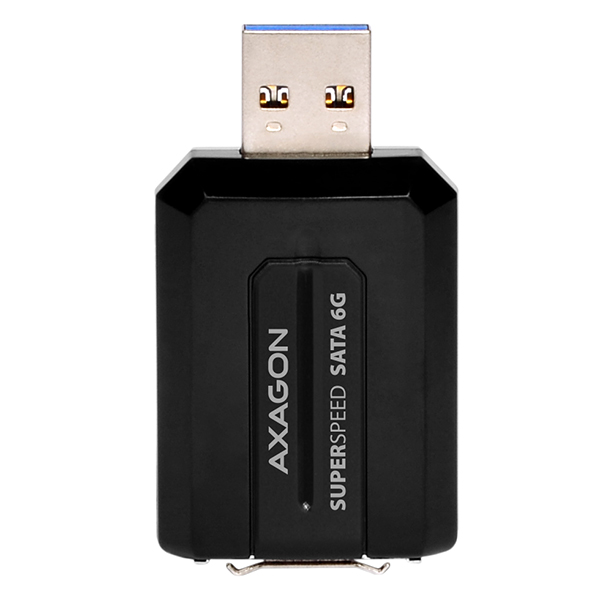
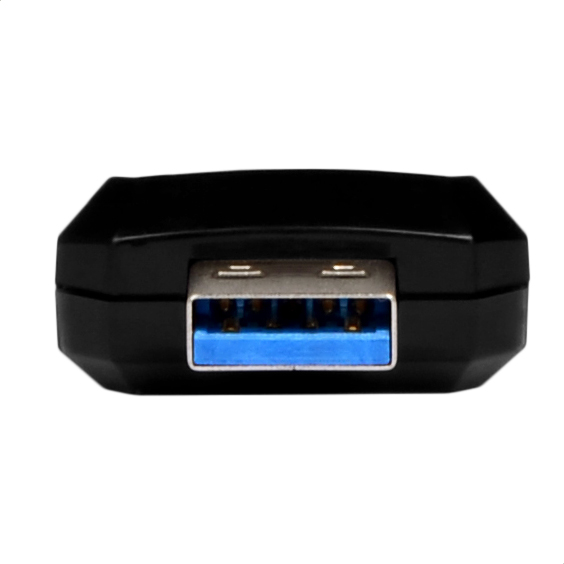




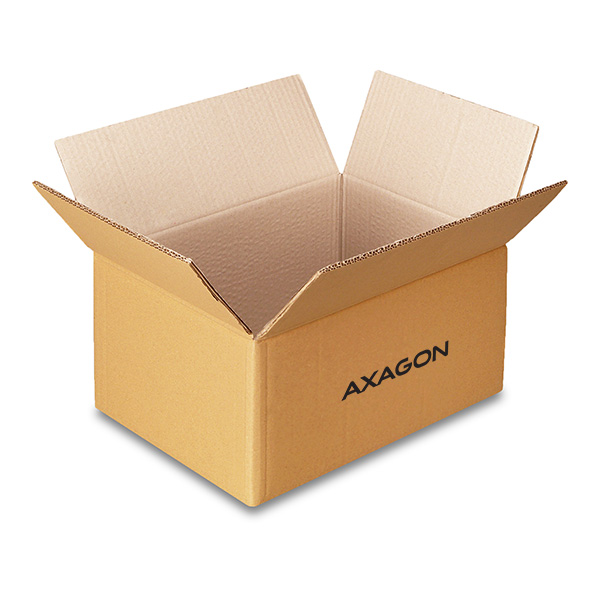
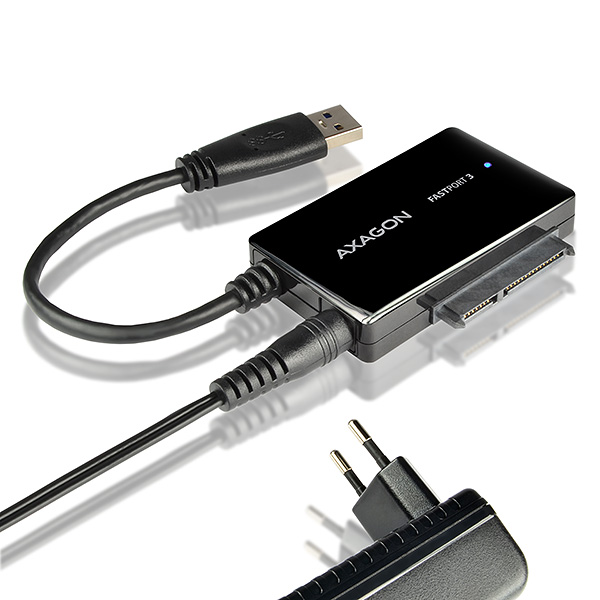 ADSA-FP3
ADSA-FP3
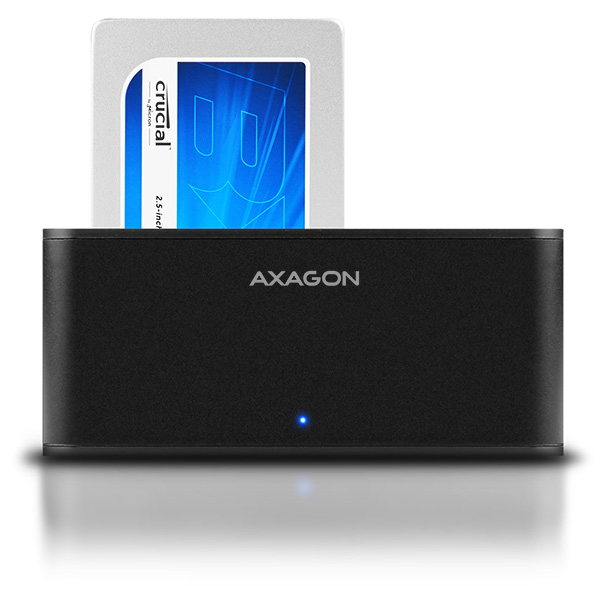 ADSA-SMB
ADSA-SMB

